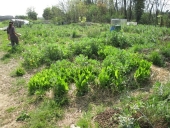... a hopefully lighthearted series of posts documenting my ‘learning by observation’ process while enjoying lockdown gardening. The first episode is entitled:
‘Edge Effects - The Dark Side’
If you have done some reading of permaculture you will have come across the idea of edge effect. Stuff happens at edges. Plants grow more vigorously, in greater variety. Microclimates can nurture species that might otherwise not survive. I have previously enjoyed edges, but today’s rant is about their dark side.
I have been the keen, but absentee, tender of a vegetable garden for years. The perennials have survived my neglect. But my visits have always been battles with weeds. In my climate and conditions the enemies are creeping buttercups, bindweed and stinging nettles. Get busy at work for a couple of weeks and by the time you check back your veggies have been swamped.
In our old arrangement we had traditional raised beds with wooden edging boards. They rotted years ago, and I eventually got rid of them as they were nothing more than slug hotels. Slugs LOVE edging boards. But between the beds we had ‘grass’ paths. I say grass because they were periodically mowed. I later came to realise that these paths were nothing more than safe zones for the buttercup and bindweed. Miss weeding for a week and half the bed would be invaded by new buttercup runners, sending their babies to root around the lettuce! And ignore the bindweed for two long and they will pull the branches of every berry bush down to the ground.
This year I abolished edges in the growing area. I tilled the whole lot (a rant for another day) and mulched the beds with
compost and the paths with wood chips. My original plan to till was driven by a need to prepare a lot of beds quickly for my lockdown garden, but here was the discovery.
Most of my time in the garden had been used by endlessly weeding these horrible perennials. My gardening had become very unfunny as a result. Now, with internal edges abolished, and with copious use of wood chip mulch, I’m gardening an area five times as large with less effort and more productivity. I have obliterate the buttercup from my main growing areas, which would have previously been impossible. Still working on the bindweed, but I feel like I’m winning for the first time ever.
Having used beds edged with wood, and between bed areas with grass for many years, I will never be going back.
Edited: adding photos from a second device








